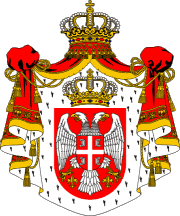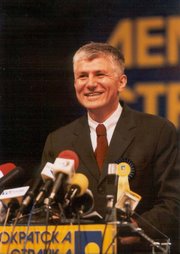1878.

Cele-kula is a serbified turkish word which origine is "kelle kulesi" - skull tower.
"Qu'ils laissent subsister ce monument! Il apprendra a leurs enfants ce que vaut l'independance d'un peuple, en leur montrant à quel prix leurs peres l'ont payée."
"My eyes and my heart greeted the remains of those brave men whose cut-off heads made the cornerstone of the independence of their homeland. May the Serbs keep this monument! It will always teach their children the value of the independence of a people, showing them the real price their fathers had to pay for it."
Alphonse de Lamartine, "Voyage to the East", 1833
***
Stevan Sinđelić (Стеван Синђелић) (1770-May 19th 1809) was a commander (vojvoda) of the First Serbian Uprising. His name became synonymous with courage among many Serbs.
On the day of Holy Trinity, May 19, 1809 (during First Serbian uprising), the Ottoman Turks marched out of Niš and headed towards Sinđelić's trenches with 3,000 strong cavalry and four cannons.
When the poles around the Čegar trenches gave in, when yataghans and knives flashed, when the breath of far more superior enemy was felt, the commandant, Stevan Sindjelić from Resava, waited until the Turks entered the trenches.
When Sinđelić saw the trenches were filled with Turkish bodies, which still didn't stop the enemy from charging in over the dead and fighting his men with rifle butts, he opened the trench gate and told his soldiers they were free to attempt avoiding certain death by leaving the field of battle if they wished so.
His famous words were: Save yourselves brothers, who wants and who can! Who stays will die!
He himself took a position in the middle of the trench where the gunpowder was stored.
He took his handgun from his belt and reloaded it.
When the Turks swarmed the trench from all sides and headed for him Sinđelić fired his handgun into the gunpowder container, triggering a huge explosion that shook the surrounding fields and hills. Thick smoke engulfed the trench and billowed skyward.
The Serbs that were still in the trench with Sinđelić and the attacking Turks were all blown into the air and killed.
This explosion ended the life of a man know as the "falcon of Cegar", the commander of Resava, Stevan Sinđelić.
Every single one of Cegar Hill defenders died, but the explosion also killed a great number of Turkish soldiers.
The Turks could not forget, nor forgive it.
So, soon after, they assembled and erected a tower of the skulls of dead Serbs as a warning to Serb population, the famous and still standing Cele-kula by the side of the road towards Constantinople (Istanbul).
Cele Kula - the Tower of Skulls, was built from the skulls of the Serbs killed in the battle of Cegar, near Nis, in May 1809.
The skull of the serbian commander Stevan Sinđelić, who sacrificially fired at his gunpowder depot in order to avoid surrendering to the Turks, killing himself, the rest of his men, and the advancing Turks, was placed at the top of the Tower.
It is of rectangular shape, about 3 m high and was built from quicklime, sand and the skinned skulls according to the order of Khurshid Pasha, the brutal turkish commander, who sent the skulls filled with cotton to the Sultan Mahmud II, in Istanbul.
Each side of the Tower has 14 rows with 17 openings where the skulls were embedded.
There were around 952 skulls, but today only 58 have remained. The rest were pulled out to be buried, or were lost in time.
The main purpose of the turkish vanquisher was to intimidate not only the Serbs. Having built it next to the road to Constantinople, aimed to be clearly visible and threatening, the Osmanli power wanted to put in fear all the dominated nations.
Being unique in form and universal in message it conveys, the tower may well be included in the world cultural heritage.
It had been unprotected and exposed to deterioration due to the weather conditions up to the year 1892, when it was covered by a chapel.
Skull Tower represents a unique monument of this kind in the world, and it faithfully depicts the true nature of the turkish crimes against the serbian people.
A tower built out of the skulls of immortal heroes of the battle of Čegar is a memento to humanity, to the spirit of freedom in tormented enslaved people, to the vandalism of vanquishers and their unprecedented cruelty.
It is an everlasting memory to be kept by the mankind.
The monument commemorating the battle in the form of a guard tower was built in 1927 on Čegar Hill by Julian Djupon. The lower part is made out of stone from the Niš fortress.
In front of the chapel stands the monument to Sinđelić (1937).












